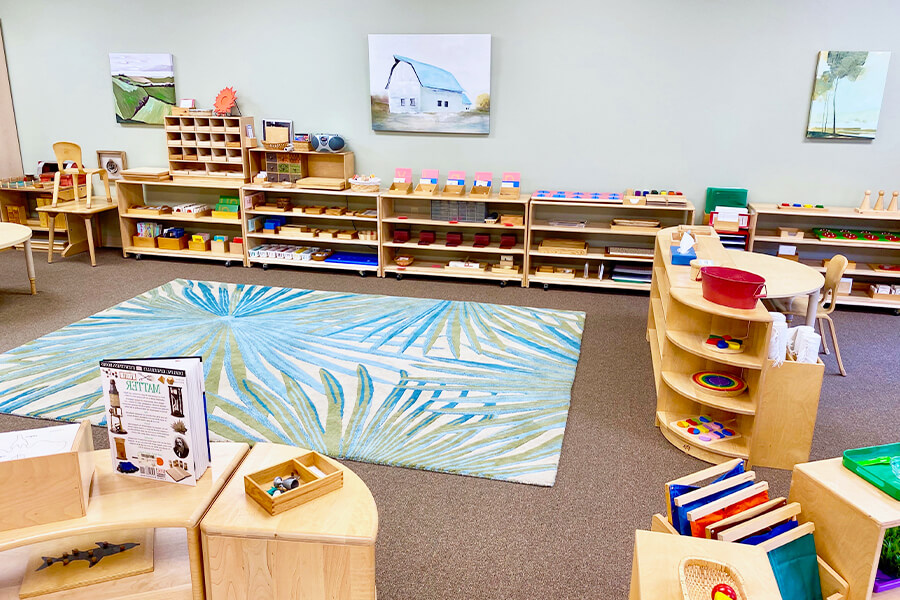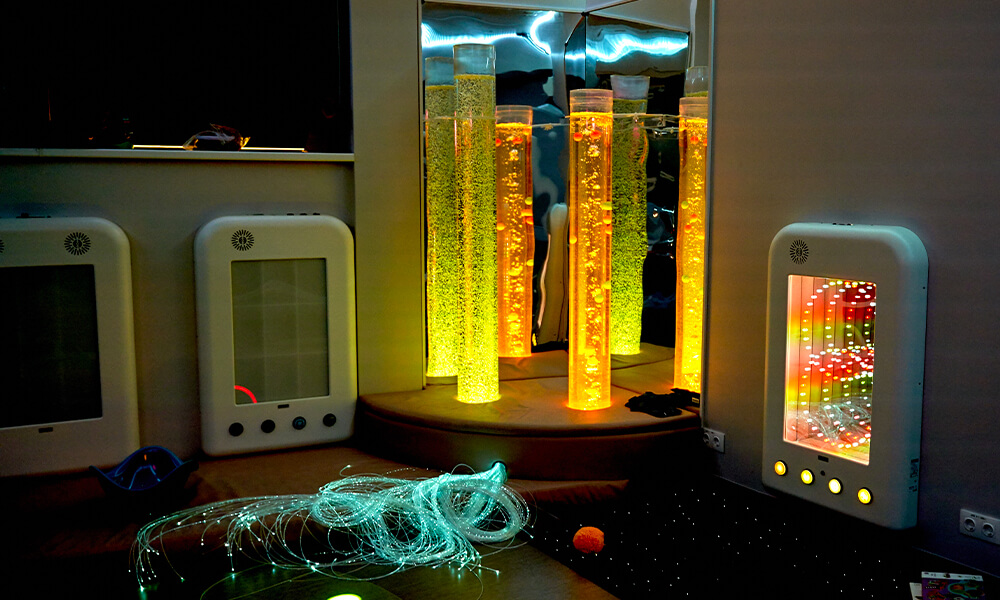Snoezelen rooms, also known as multisensory environments, provide a therapeutic space designed to stimulate the senses and promote relaxation. Originating from the Netherlands in the late 1970s, these unique spaces have gained popularity worldwide for their positive impact on various populations, including individuals with autism, dementia, and other cognitive or sensory impairments. This article will explore the features of Snoezelen rooms and discuss how they compare to Montessori prepared environments.
What is a Snoezelen Room?
A Snoezelen room is a specially designed space that offers a variety of sensory experiences using light, sound, touch, and smell to engage and calm the individuals who visit. Each room is unique, catering to the specific needs and preferences of the users. Some common elements of a Snoezelen room may include:
- Visual stimulation: Fiber optic lights, bubble tubes, and projectors create captivating visual displays.
- Auditory stimulation: Soothing sounds, music, or white noise fill the space.
- Tactile stimulation: Textured surfaces, fabrics, and objects provide tactile input.
- Olfactory stimulation: Aromatherapy and scents create a calming atmosphere.
Snoezelen rooms aim to reduce stress and anxiety, improve mood, and promote relaxation, social interaction, and self-esteem.
The Benefits of Snoezelen Rooms
Snoezelen rooms have gained recognition for their numerous benefits in catering to individuals with various needs and abilities. Let’s delve deeper into some of the most notable advantages:
-
Reduced anxiety and stress
The multisensory environment of a Snoezelen room is designed to create a calm and soothing atmosphere, helping users feel more relaxed and at ease. The combination of gentle lighting, soft sounds, pleasant scents, and tactile elements can help regulate the nervous system, reducing stress hormones and promoting a sense of tranquility. As a result, individuals experiencing anxiety or stress-related disorders may find significant relief in a Snoezelen room.
-
Improved focus and attention
Engaging the senses in a controlled environment can help increase concentration and reduce distractions for individuals who struggle with attention-related challenges, such as ADHD. The Snoezelen room’s sensory stimuli can help ground users in the present moment, allowing them to better focus on the task at hand or simply enjoy their surroundings without being overwhelmed by external distractions.
-
Enhanced communication and social skills
The calming atmosphere of a Snoezelen room encourages individuals to interact with others and express themselves more openly. For individuals with communication challenges or social anxiety, the room’s non-threatening environment can foster a sense of safety and trust, allowing them to develop their social skills and form meaningful connections with others.
-
Increased self-esteem
The freedom to explore and interact with the environment at their own pace can lead to a sense of accomplishment and self-confidence for users. As individuals engage with the various sensory elements and overcome any apprehensions or hesitations, they may develop a stronger sense of self-efficacy and pride in their abilities.
-
Enhanced emotional regulation
The soothing environment of a Snoezelen room can help individuals better understand and manage their emotions. By engaging with different sensory experiences, users can learn to identify and express their feelings more effectively, promoting emotional well-being and resilience.
-
Improved sensory integration
Snoezelen rooms can help individuals with sensory processing disorders or difficulties in integrating sensory input to better tolerate and process various sensory experiences. The controlled environment allows users to gradually acclimate to different stimuli, leading to improved sensory integration over time.
-
Supports cognitive function
Snoezelen rooms can provide cognitive stimulation through sensory engagement, helping individuals with cognitive impairments, such as dementia or brain injury, to maintain and improve their cognitive abilities.
-
Promotes relaxation and self-regulation
For individuals who experience sensory overload or difficulty self-regulating, Snoezelen rooms offer a space where they can learn to manage their sensory experiences, promoting relaxation and self-regulation skills.
By catering to the unique needs of diverse populations, Snoezelen rooms provide a versatile and effective therapeutic approach that can significantly improve the well-being and quality of life for many individuals.
Who can benefit from Snoezelen therapy?
Snoezelen therapy, utilizing a Snoezelen room or multisensory environment, offers numerous benefits to various individuals.
- Autism Spectrum Disorder (ASD): Snoezelen rooms create a calming environment, reducing sensory overload and anxiety while enhancing focus, communication, and social skills for individuals with ASD.
- Intellectual and Developmental Disabilities: This therapy provides a safe, engaging space for individuals with various cognitive and developmental disabilities, supporting relaxation, self-expression, and sensory integration.
- Dementia or Alzheimer’s Disease: Snoezelen rooms alleviate agitation, anxiety, and restlessness while promoting relaxation, mood improvement, and cognitive stimulation for those affected by dementia or Alzheimer’s.
- Attention Deficit Hyperactivity Disorder (ADHD): A Snoezelen room’s soothing atmosphere improves focus, reduces impulsivity, and relieves stress for children with ADHD.
- Sensory Processing Disorders: Snoezelen therapy offers a controlled environment that helps individuals with sensory processing disorders regulate their sensory experiences and engage with sensory stimuli.
- Anxiety and Stress-Related Disorders: The calming atmosphere of a Snoezelen room alleviates stress, anxiety, and tension, promoting relaxation and emotional well-being.
- Physical Disabilities or Chronic Pain: Snoezelen therapy provides a comfortable, supportive environment that encourages relaxation and pain relief through sensory stimulation.
- Trauma Recovery and Post-Traumatic Stress Disorder (PTSD): Snoezelen rooms offer a safe, calming space for individuals to process and cope with traumatic experiences.
- Stroke Survivors and Brain Injuries: Snoezelen therapy supports cognitive function, sensory integration, and relaxation for individuals recovering from stroke or brain injuries.
Snoezelen therapy can also benefit individuals without specific impairments, as it provides a relaxing environment that encourages stress reduction and emotional well-being. Each Snoezelen room can be tailored to the unique needs and preferences of its users, making it a versatile therapeutic option for a diverse array of populations.
Creating a Snoezelen Room: A Step-by-Step Guide
Designing a Snoezelen room requires careful planning and attention to detail to ensure that the environment is tailored to the specific needs and preferences of the individuals who will use it. Follow these steps to create an effective and engaging Snoezelen room:
- Assess the needs of your target population: Identify the sensory preferences, abilities, and challenges of the individuals who will use the room. Consult with professionals, such as occupational therapists, psychologists, or special education teachers, for guidance.
- Choose a suitable space: Select a room that is quiet, easily accessible, and large enough to accommodate the desired sensory equipment and furniture. Consider factors such as lighting, temperature, and noise levels, as these can greatly impact the overall sensory experience.
- Develop a layout: Plan the arrangement of furniture and sensory equipment to create a clear and uncluttered space that encourages exploration and interaction. You may want to divide the room into distinct areas, each catering to a specific sense or theme.
- Select sensory equipment and materials: Choose a variety of sensory tools and equipment that address the needs and preferences of your target population. Some popular options include:
- Visual: Fiber optic lights, bubble tubes, projectors, and light-up toys
- Auditory: Sound machines, speakers, musical instruments, or soft chimes
- Tactile: Textured surfaces, fidget toys, soft cushions, or weighted blankets
- Olfactory: Aromatherapy diffusers, scented candles, or calming essential oils
- Install appropriate lighting: Use adjustable lighting, such as dimmer switches or colored filters, to create a soothing and calming atmosphere. Avoid using harsh fluorescent lights, which can be overstimulating for some individuals.
- Create a comfortable seating area: Provide a variety of seating options, such as bean bags, soft cushions, or rocking chairs, to allow users to relax and engage with the environment at their own pace.
- Ensure safety: Make sure all electrical cords are securely fastened, and install padding on sharp edges or corners. Regularly inspect and maintain equipment to ensure that it remains in good working order.
How to use a Snoezelen Room Properly?
To get the most out of your Snoezelen room, follow these guidelines for proper use:
- Supervise users: Although Snoezelen rooms are designed for exploration and interaction, always ensure that a responsible adult or trained professional is present to monitor users and provide assistance as needed.
- Allow time for acclimation: Give individuals time to become familiar with the room and its various sensory elements before encouraging them to engage with the equipment.
- Follow individual preferences: Observe the users’ reactions to different sensory stimuli and adjust the environment accordingly. This may involve adjusting the lighting, sounds, or scents, or introducing new materials that cater to their preferences.
- Encourage interaction and engagement: Guide users to explore the room and engage with the various sensory elements at their own pace. Be patient and offer support when needed.
- Use the room for therapy and relaxation: Snoezelen rooms can be used for both individual and group therapy sessions or as a calming space for individuals experiencing sensory overload or anxiety. Adjust the environment and activities according to the specific goals of each session.
- Monitor progress: Keep track of users’ experiences, preferences, and progress in the Snoezelen room. Use this information to refine the environment and therapy sessions over time.
By following these guidelines, you can create a Snoezelen room that provides a beneficial and enjoyable sensory experience for a diverse array of individuals.
Comparing Snoezelen Rooms and Montessori Prepared Environments
Montessori prepared environments, founded by Maria Montessori in the early 20th century, are educational spaces designed to foster independence, exploration, and learning through hands-on experiences. These environments prioritize order, beauty, simplicity, and accessibility, with carefully chosen materials and activities that cater to the specific developmental needs of the children who use them.

In contrast to Snoezelen rooms, Montessori environments are characterized by the following features:
- Prepared Environment: Montessori classrooms are meticulously organized and structured, with materials and activities arranged according to specific learning areas such as language, mathematics, and practical life skills. This organization enables children to work independently and make choices based on their interests and developmental needs.
- Mixed-Age Groups: Montessori classrooms typically consist of children spanning a range of ages, allowing for peer learning and mentorship. Older children can support and guide younger peers, while younger children benefit from observing and imitating their older counterparts.
- Individualized Learning: Montessori education recognizes that each child has unique learning needs and preferences. Teachers observe children closely and provide individual guidance and support, allowing them to progress at their own pace.
- Focus on Practical Life Skills: Montessori environments emphasize the development of practical life skills, such as dressing, cooking, and cleaning, that foster self-sufficiency and independence.
- Materials and Manipulatives: Montessori classrooms feature a variety of specially designed materials and manipulatives that promote hands-on learning and active engagement with concepts.
While both Snoezelen rooms and Montessori environments share some similarities in their focus on individual needs and sensory experiences, there are key differences between the two:
- Purpose: The primary purpose of a Snoezelen room is therapeutic and centered on relaxation, while Montessori environments are designed for education and development.
- User population: Snoezelen rooms cater to a wide range of individuals, including those with cognitive or sensory impairments, while Montessori environments are typically geared toward children without specific impairments.
- Structure and activities: Snoezelen rooms provide unstructured, immersive experiences with no set goals or expectations. Montessori environments, on the other hand, offer structured activities designed to encourage specific learning outcomes.
In summary, while both Snoezelen rooms and Montessori prepared environments aim to create positive, individualized experiences, they serve different purposes and cater to different populations. Snoezelen rooms focus on providing therapeutic and relaxing sensory experiences, while Montessori environments emphasize hands-on learning and child-centered education.




